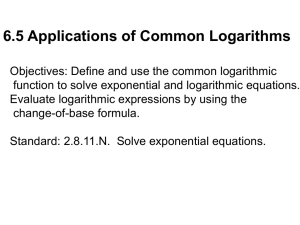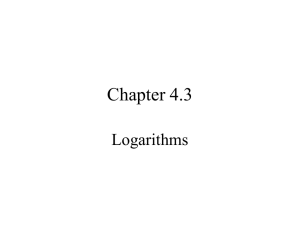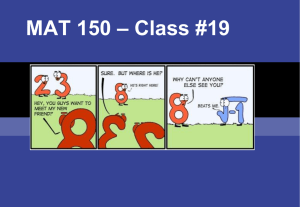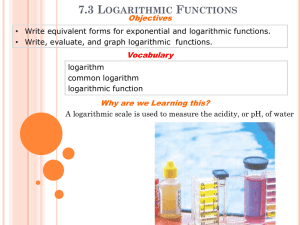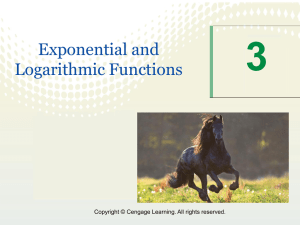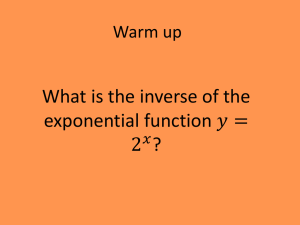week10
advertisement
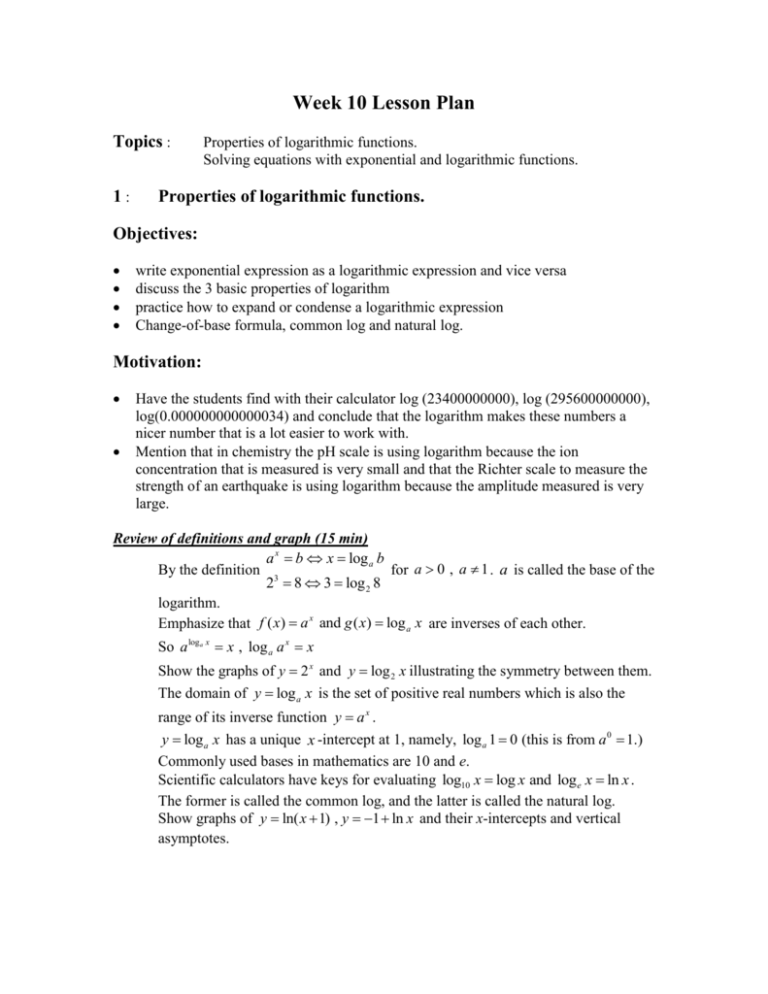
Week 10 Lesson Plan Topics : 1: Properties of logarithmic functions. Solving equations with exponential and logarithmic functions. Properties of logarithmic functions. Objectives: write exponential expression as a logarithmic expression and vice versa discuss the 3 basic properties of logarithm practice how to expand or condense a logarithmic expression Change-of-base formula, common log and natural log. Motivation: Have the students find with their calculator log (23400000000), log (295600000000), log(0.000000000000034) and conclude that the logarithm makes these numbers a nicer number that is a lot easier to work with. Mention that in chemistry the pH scale is using logarithm because the ion concentration that is measured is very small and that the Richter scale to measure the strength of an earthquake is using logarithm because the amplitude measured is very large. Review of definitions and graph (15 min) a x b x log a b By the definition 3 for a 0 , a 1 . a is called the base of the 2 8 3 log 2 8 logarithm. Emphasize that f ( x) a x and g ( x) log a x are inverses of each other. So a loga x x , log a a x x Show the graphs of y 2 x and y log 2 x illustrating the symmetry between them. The domain of y log a x is the set of positive real numbers which is also the range of its inverse function y a x . y log a x has a unique x -intercept at 1, namely, log a 1 0 (this is from a 0 1.) Commonly used bases in mathematics are 10 and e. Scientific calculators have keys for evaluating log10 x log x and log e x ln x . The former is called the common log, and the latter is called the natural log. Show graphs of y ln( x 1) , y 1 ln x and their x-intercepts and vertical asymptotes. Properties of logarithms (15 min) Introduce logarithm properties parallel with reviewing the properties of exponential terms: 1. a n a m a n m log a ( x y) log a x log a y 2. an a nm m a 3. ( a t ) n a t n x log a log a x log a y y log a ( x n ) n log a x For teachers’ reference and maybe for 170 courses the proofs: 1. The logarithm of a product is the sum of the logarithm. log a ( xy) log a x log a y (Proof) Use the identity a log a x x replacing x by xy . We then have aloga ( xy ) xy (a loga x )(a loga x ) a loga x loga y . The last equality is from a m a n a mn . Equating the first and last expression, we have log a ( xy) log a x log a y 2. The logarithm of a quotient is the difference of the logarithm. log a ( x / y) log a x log a y (Proof) Use the identity a log a x x replacing x by x / y . We then have aloga ( x / y ) x / y (a loga x ) /(a loga x ) a loga x loga y . The last equality is from a m / a n a mn . Equating the first and last expression, we have log a ( x / y) log a x log a y . 3. The logarithm of a number raised to a power is the product of the power and the logarithm of the number. log a x r r log a x (Proof) Use the identity a log a x x replacing x by x r . r We then have aloga x xr (aloga x )r ar loga x . The last equality is from (a m )n a mn . Equating the first and last expression, we have log a x r r log a x . (Remark) Show only one proof in class and assign the other as homework. Examples ( 20 min ) 1. Expand the following: 2. Write as a single logarithm: log (x3y/z) 4ln x + 2ln y + 3ln z For MAT 170 classes or for group work more advanced problems are recommended: 1. Expand the following. (3x 2)3/ 2 ( x 1)3 log 3 x x 1 (3 x 2)3/ 2 ( x 1)3 log 3 x( x 1)1/ 2 log 3 (3x 2)3/ 2 ( x 1)3 log 3 x( x 1)1/ 2 log 3 (3x 2)3/ 2 log 3 ( x 1)3 log 3 x log 3 ( x 1)1/ 2 3 1 log 3 (3x 2) 3log 3 ( x 1) log 3 x log 3 ( x 1) 2 2 (Some similar problems) ln x 3 x2 ( x 2)3 ln x x 1 x2 2. Write as a single logarithm. 1 2 ln x 3ln( x 1) ln( x 1) 3 2 3 ln x ln( x 1) ln( x 1)1/ 3 ln x 2 ln( x 1)3 ln 3 x 1 x 2 ( x 1)3 3 x 1 (Some similar problems) ln( x 2 x 1) 3ln( x 2) ln x ln 1 2 ln x ln( x 1) 3 3. Evaluate the following expressions log 2 32 log 2 25 5log 2 2 5 1 5 log8 212 log8 234 log8 (23 ) 4 log 8 84 4 log 8 8 4 1 4 log 9 3 log 9 9 log 9 91/ 2 (1/ 2) log 9 9 1/ 2 5log5 6 6 e 2ln eln 2 (Some similar problems) log10 0.001 2 log 4 1 2 e 1/ 2ln16 4. For more fun and for better students you could also assign: Find log 75 and log 540 without your calculator if it is given that log 3 = 0.4771 and log 5 = 0.699. Warn the students of the following mistakes. log a ( xy ) (log a x)(log a y ) log a ( x / y ) 2: log a x log a y log a x r (log a x) r Make sure that all the properties can be used only when the logarithms have the same base. log3 x log 2 y cannot be combined into one expression easily. Change-of-base formula and exponential equations. Objectives: write any logarithmic expression with the common log and natural log. discuss the basic steps of solving exponential equations gradually introduce more difficult examples; apply techniques of solving linear and quadratic equations to solving exponential equations. Motivation: the calculator only has common and natural logarithm on it find the time within the money doubles in your savings account predict the population of a given city or country for the future determine the age of a fossil or an old painting using radioactive carbon dating Change of base formula(10 min) log b x log a x log b a (Remarks) Usually the change of base formula is used to convert a general logarithm into the common logarithm or natural logarithm. (see proof later, after the exponential equations) (Example) log10 5 ln 5 log10 3 ln 3 Show your students how to use the calculator for the above computation. log 3 5 Have the students calculate the same example using both the common and the natural logarithm to change the expression and point it out that you are getting the same result. Strategies for exponential equations (35 min) 1. For the problem of the form a f ( x ) b with constants a , b , take the logarithm of base a (or by definition) to get f ( x) log a b . Then solve for x . 52 x 1 2 (a) 2 x 1 log 5 2 x 1 log 5 2 2 this gives the EXACT answer. This is quite unusual and difficult for the students to understand (b) log 2 1 log 5 x = .29337 2 this gives an APPROXIMATE answer. Warn the students of the rounding mistakes. It is important that many decimals are kept in the answers for the exponents because otherwise significant errors can occur. 2. By taking the log on both sides of the equation, we can bring down the variables of exponents. a f ( x ) b g ( x ) f ( x) ln a g ( x) ln b . 2 x2 e x / 2 ( x 2) ln 2 ( x / 2) ln e x ln 2 2 ln 2 x / 2 x ln 2 x / 2 2 ln 2 x(ln 2 1/ 2) 2 ln 2 2 ln 2 1 x( ) 2 ln 2 2 4 ln 2 x 2 ln 2 1 (Some similar problems) 97 3 x 5 3e x 43 x 1 3. By introducing a new variable, exponential equations can be reduced to quadratic equations 3 2 x 6 3 x 5 u 2 6u 5 0 can be reduced to 4. Application problems Find the time required to double $1000 investment at interest rate 6.875% compounded continuously. 3: Logarithmic equations. Objectives: discuss the basic steps of solving logarithmic equations gradually introduce more difficult examples; apply the logarithmic properties and techniques of solving linear and quadratic equations to solving logarithmic equations. Motivation: find the change in the noise level after the installation of a muffler of a car Review of properties of logarithms (10 min) log a xy log a x log a x log a ( x / y ) log a x log a y log a x r r log a x a loga x x log a a x x Choose one from each problem set of previous lecture. Change of base formula(10 min) log b x log a x log b a (Proof) for teachers references and MAT 170. Now that we had exponential equations we are ready for the proof: Start from the identity a log a x x . Take the logarithm of base b for both sides. Then log b a log a x log b x (log a x) log b a log b x log a x log b x . log b a Logarithmic equations (30 min) 1. Basic strategy for logarithmic equations 1. Use logarithmic properties to get log a f ( x) b. Here a and b are numbers. 2. By the definition (or exponentiation) we have f ( x) ab . 3. Solve for x . (Examples) log 2 x 5 x 25 ; 1 ln(3 x 2) 0 ln(3 x 2) 1 3 x 2 e1 e2 x 3 (Some similar problems) log3 (2 x) 2 log3 x log3 2 2 2. Sometimes it is easy to use log a f ( x) log a g ( x) f ( x) g ( x) for positive functions f ( x), g ( x) . This is true because logarithmic functions are one-to-one. 2 ln x ln 4 ln( x 3) ln x 2 ln 4( x 3) x 2 4( x 3) x 2 4 x 12 0 ( x 6)( x 2) 0 x 6, 2 x 6 is the only answer as 2 is not in the domain of ln x. (Problems) ln x ln( x 1) ln 2 ln 2 ln( x 1) ln(4 x 7) 1 2. log f ( x ) a b log f ( x ) a 1 log f ( x ) a1/ b 1 f ( x) a1/ b b log x 4 2 (1/ 2) log x 4 1 log x 41/ 2 1 x 41/ 2 2 (Problem) 1 log x 3 3 Warn the students of the following. The quadratic equation could bring in solutions that are not solutions to the original logarithmic equation, always check the domain of the original problem. Sometimes we get extraneous solutions. ln x 2 1 x 2 e x e 2 ln x 1 1 1/ 2 ln x x e x e 2 Strictly speaking, f ( x) ln x 2 and g ( x) 2ln x have different domains. Tell students to check their answers by substituting them in the original equation to remove any extraneous solutions. Recommended challenge questions for interested, bright students and their teachers: Solve the following system of equations: x y y x 3/ 2 x y y x 3 Solve the following system of equations: 3log x 5 log y 14 3 2 log x 5 2 log y 56 Solve the following equation: log 5 ( x 4) log 5 ( x 3 2) log 0.2 ( x 4) 4

